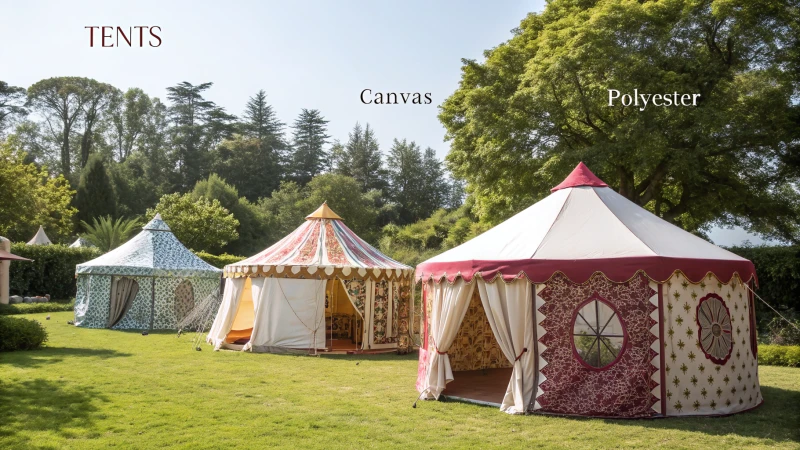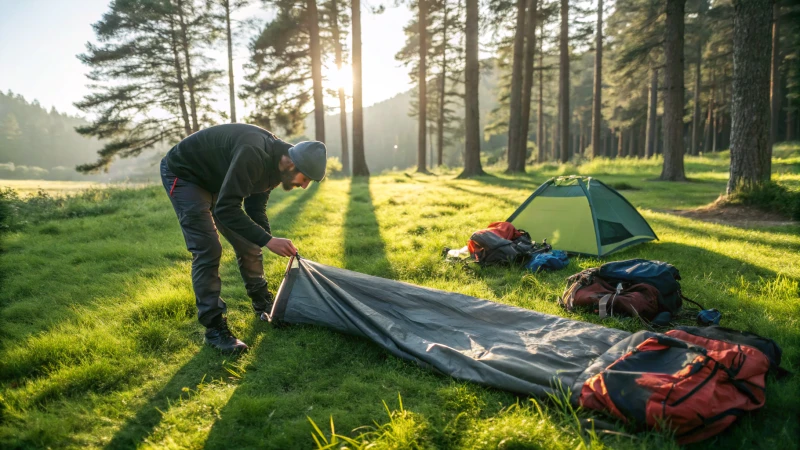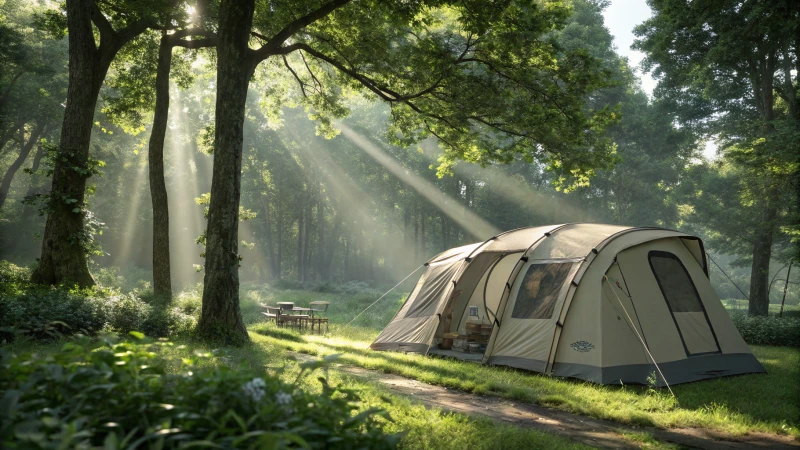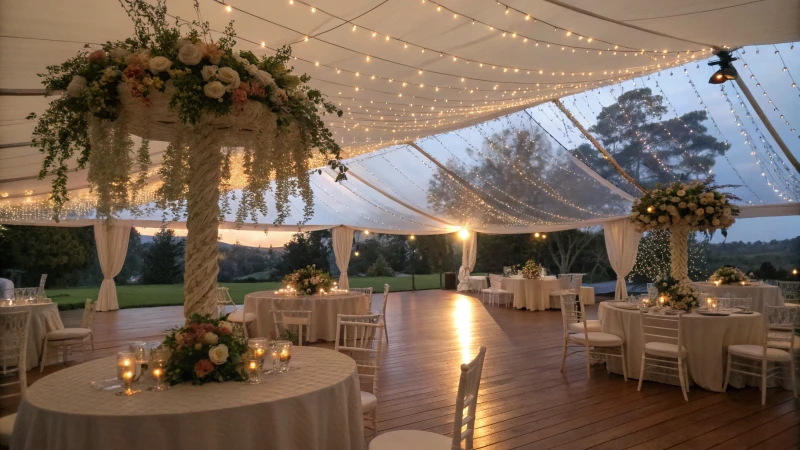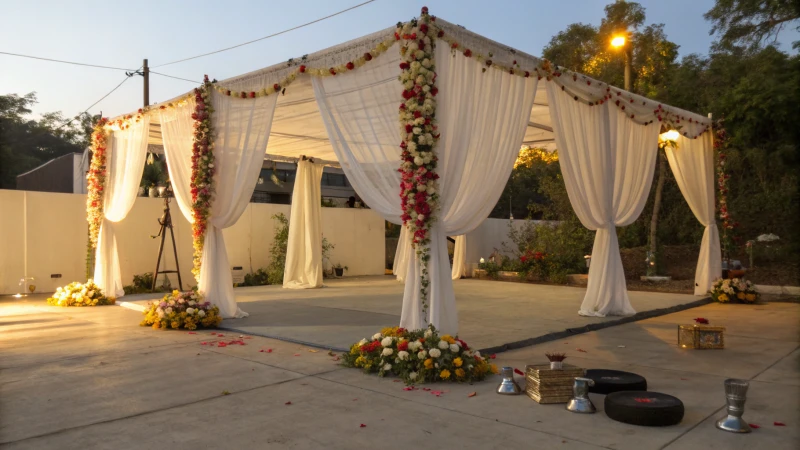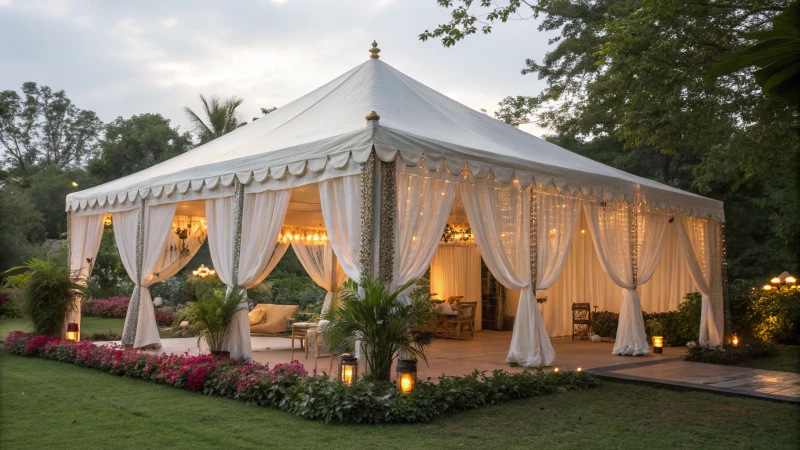
Ever been worried about your marquee tent collapsing mid-event? Understanding its weight capacity can save the day.
A marquee tent’s weight capacity depends on its frame material, roof design, and size. Typically, they support 10–20 kg per attachment point for hanging items and manage 25–50 kg per square meter of snow load. Ensuring proper anchoring and weight distribution is essential for maximum durability and safety.
I remember the first time I set up a marquee tent for a big family reunion. As I watched my relatives decorate with lights and banners, I couldn’t help but wonder if the tent could handle it all. That’s when I realized how crucial it is to know exactly what your marquee can bear.
The type of frame material plays a huge role. Aluminum frames, though lightweight, can surprise you with their strength, supporting 25–100 kg per pole depending on their thickness. On the other hand, steel frames bring even more durability, handling 50–150 kg per pole, making them ideal for those longer-lasting setups.
Roof design is another biggie. I’ve seen how high-peaked roofs effortlessly distribute weight, allowing for heavier loads, while dome roofs are champs in managing snow or water.
And don’t overlook the fabric strength! High-quality PVC-coated polyester can support extra decorations like those fairy lights I love, usually up to 10–20 kg per attachment point. But remember, evenly distributing weight is key.
So, whether you’re planning an intimate gathering or a grand event, knowing these details ensures your marquee tent stands strong and safe.
Marquee tents can support 10–20 kg per attachment point.True
Marquee tents are designed to handle 10-20 kg per attachment point for hanging items.
All marquee tents can handle 50 kg per square meter of snow load.False
Snow load capacity varies by tent design; not all can handle 50 kg/m².
What Factors Affect the Weight Capacity of a Marquee Tent?
Ever found yourself at an event, looking up at a towering marquee tent and wondering just how much it can handle?
A marquee tent’s weight capacity hinges on factors like frame material, roof design, fabric strength, anchoring system, and overall size. Together, these determine the safe weight a tent can support during an event.
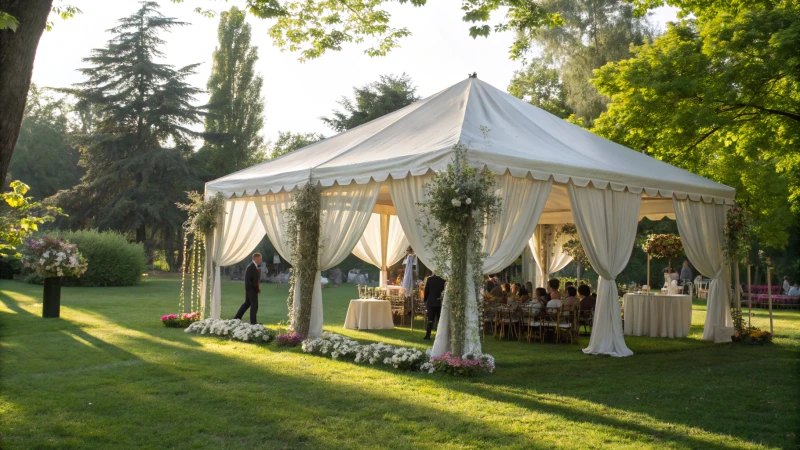
Frame Material Impact
When I first started exploring the world of marquee tents, I quickly learned that the frame material plays a huge role in weight capacity. Aluminum frames are surprisingly robust for their lightness—think about supporting anywhere from 25 to 100 kg per pole! It’s like finding out your lightweight gym buddy can actually bench press a lot more than you’d expect. On the other hand, steel frames are the heavyweights in the tent world, handling 50 to 150 kg per pole. Choosing between these materials1 often comes down to what kind of event you’re hosting and how long the setup will be in place.
Roof Design and Load Distribution
I remember setting up for a winter wedding once, and I was worried about snow piling up on the tent. That’s when I realized how crucial roof design is. High-peaked roofs are like magicians at distributing weight evenly, unlike their flat counterparts. And if you ever expect heavy loads—like that surprise snowstorm during an outdoor event—dome or arched designs are your best friends. Always check if your design matches the local weather conditions2 to avoid any mishaps.
Fabric Strength and Attachments
Ever tried hanging fairy lights or chandeliers inside a tent? The fabric strength becomes your go-to concern. High-quality PVC-coated polyester can support 10–20 kg per attachment point, perfect for creating that dreamy atmosphere without worrying about things crashing down. Just ensure your attachments align with the manufacturer’s guidelines3 to keep everything secure.
Anchoring System Importance
One windy day taught me never to underestimate the importance of a good anchoring system. Whether it’s ground stakes, ballast weights, or ground screws, these are vital for keeping your tent stable under extra loads. A comprehensive anchoring system4 ensures that everything stays put even on uneven terrains or during unexpected gusts.
| Factor | Effect on Weight Capacity |
|---|---|
| Frame Material | Determines base load per pole |
| Roof Design | Affects load distribution efficiency |
| Fabric Strength | Influences hanging item capacity |
| Anchoring | Ensures stability under extra loads |
Tent Size and Structural Support
Larger tents are like the superheroes of events; they come with more poles and supports, enabling them to handle greater distributed loads. However, bigger isn’t always better if you don’t consider the setup and maintenance challenges they bring. Always calculate the required size based on your event scale5 to avoid exceeding weight limits.
Understanding these factors not only helps in selecting or customizing a marquee tent that fits your needs but also ensures everyone’s safety during your event. Whether it’s a wedding under a starry sky or a corporate retreat in an open field, getting these details right makes all the difference.
Aluminum frames support up to 150 kg per pole.False
Aluminum frames support 25–100 kg per pole, not up to 150 kg.
High-peaked roofs distribute weight more evenly than flat roofs.True
High-peaked roofs excel at spreading weight evenly, unlike flat roofs.
How Do Different Frame Materials Impact Load-Bearing Ability?
Choosing the right frame material is like picking the perfect dance partner—it can make or break your structure’s performance.
Frame materials like aluminum, steel, and wood significantly impact load-bearing ability due to their varying strength, weight, and flexibility. Aluminum is lightweight but strong, steel is durable and supports heavy loads, while wood offers natural flexibility.
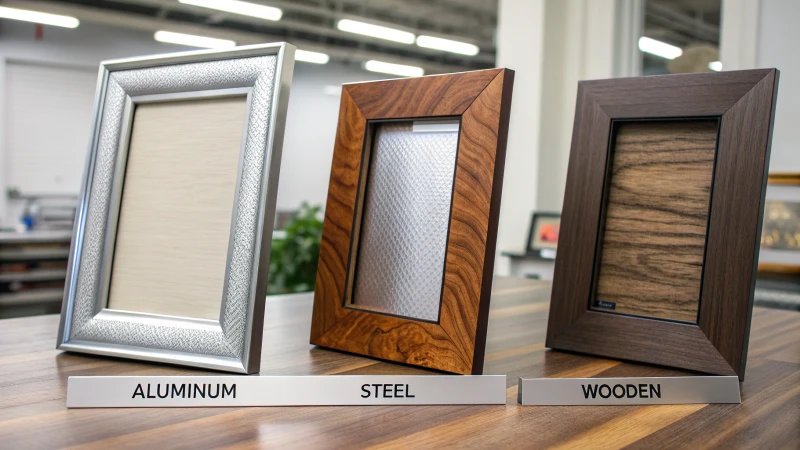
Aluminum: The Lightweight Contender
Imagine planning an event in the middle of nowhere—aluminum is like the friend who shows up early to help carry the heavy stuff without breaking a sweat. Its lightweight nature and high resistance to corrosion make it a fantastic choice for situations where mobility is key. I’ve found that when setting up portable marquee tents6, aluminum’s strength-to-weight ratio is a game-changer. Despite being light, it supports significant loads without weighing us down, and its resistance to rusting means I spend less time worrying about maintenance and more time enjoying the event.
| Feature | Benefit |
|---|---|
| Lightweight | Easy transport and setup |
| High strength | Supports significant loads |
| Corrosion resistant | Low maintenance costs |
Steel: The Heavy-Duty Choice
Steel is like the dependable older sibling who can handle anything you throw at them. For projects where maximum load-bearing capacity is non-negotiable, steel stands out. Its load capacity is impressive—supporting up to 150 kg per pole—and it’s durable enough to withstand harsh conditions. When working on industrial applications or long-term installations like industrial tents7, I know I can rely on steel to hold up under pressure, literally and figuratively.
| Feature | Benefit |
|---|---|
| High load capacity | Suitable for heavy loads |
| Durable | Long-lasting under stress |
Wood: The Flexible Natural Option
Wood reminds me of those old family homes with a story in every creak—it’s not just about flexibility; it’s about character. Though not as common in modern large-scale structures, wood’s natural flexibility allows it to absorb stress without breaking, making it ideal in seismic areas. Plus, its aesthetic appeal offers that traditional look which sometimes is exactly what you need for smaller or residential projects.
| Feature | Benefit |
|---|---|
| Flexibility | Absorbs stress effectively |
| Aesthetic appeal | Traditional look |
Each of these materials brings its own set of strengths to the table. Whether it’s the lightweight advantage of aluminum, the robust reliability of steel, or the flexible charm of wood, choosing the right one depends on balancing your specific needs—considering factors like weight, strength, cost, and environmental conditions. For deeper insights into material selection8, diving into detailed specifications can be incredibly beneficial.
Aluminum supports 150 kg per pole.False
Aluminum supports 25–100 kg per pole, not 150 kg.
Wood offers natural flexibility for stress absorption.True
Wood's flexibility helps absorb stress, especially in seismic areas.
How Does Roof Design Impact Weight Distribution?
Ever wonder how the design of a roof can make or break a building’s structural integrity?
Roof design plays a pivotal role in weight distribution by defining how loads are spread throughout a structure. High-peaked or arched roofs excel in managing weight efficiently, enhancing both stability and load-bearing capabilities.

Influence of Roof Design on Structural Integrity
When I first ventured into the world of tent design, I was fascinated by how the shape of a roof could affect everything from stability to durability. It’s similar to when I tried balancing a tray full of drinks at a party—how I held it made all the difference. High-peaked roofs distribute loads more evenly, much like how shifting your grip can prevent spills. Conversely, flat roofs remind me of those precarious moments when one wrong move and everything topples.
Comparison of Roof Designs
| Roof Type | Weight Distribution Efficiency |
|---|---|
| Flat | Low |
| High-Peaked | High |
| Arched/Dome | Very High |
High-peaked and arched roofs guide loads away from the center to the edges, reducing strain on the central framework. This is crucial in areas prone to heavy snow or rain. I’ve seen how this design element can mean the difference between a roof that weathers the storm and one that succumbs to it.
Material Choices and Their Impact
Materials are like the unsung heroes of roof design. I’ve experimented with different frames, and let me tell you, steel frames are the powerlifters, supporting heavy loads but being quite hefty themselves. On the other hand, aluminum is the agile gymnast, light yet strong enough for most events.
- Aluminum Frames: Lightweight and strong; suitable for typical event loads.
- Steel Frames: Durable and ideal for industrial applications.
Environmental Considerations
I remember setting up tents in snowy regions and realizing that high-peaked or arched roofs were lifesavers. They prevent snow from piling up, distributing the weight effectively. It’s like wearing snow boots that keep you steady instead of slipping on ice. Knowing local weather patterns can guide you in selecting designs that maximize durability9.
Importance of Proper Design in Safety
Safety is everything. A well-designed roof isn’t just about staying dry; it’s about preventing structural failures. Regular inspections, much like a routine car check-up, ensure everything runs smoothly. Adhering to manufacturer guidelines means fewer headaches down the road and ensures your roof meets both current and future needs.
For further insights, explore additional resources on effective roof designs10 and their applications.
High-peaked roofs distribute weight more evenly than flat roofs.True
High-peaked roofs channel loads to the edges, reducing central stress.
Steel frames are lighter than aluminum frames for roof support.False
Steel frames are heavier but more durable compared to aluminum.
How Can Proper Anchoring Enhance Tent Stability?
Ever worried about your tent taking off like a kite in the middle of a storm? Let me share how I tackle this fear with tried-and-tested anchoring techniques.
Proper anchoring is key to tent stability, securing it firmly to the ground with ground stakes, ballast weights, or screws. These methods prevent movement from wind or uneven surfaces, ensuring safety and peace of mind.
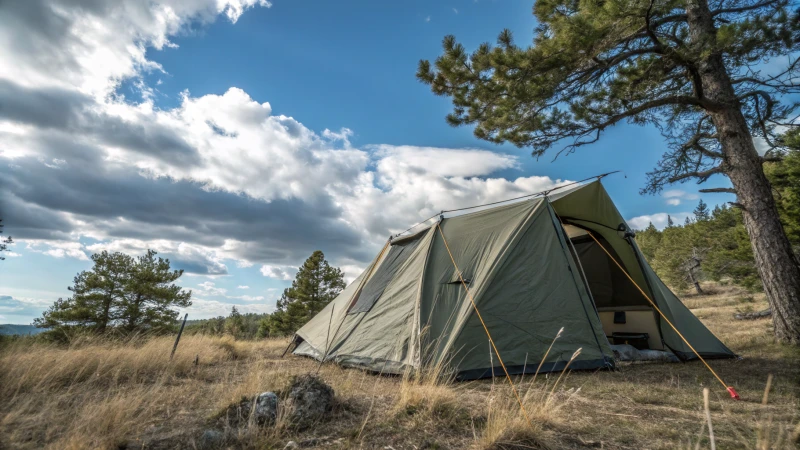
Understanding Tent Anchoring Methods
Let me tell you, there’s nothing quite like the relief of knowing your tent is rock solid, especially when the weather turns. I’ve learned from experience that choosing the right anchoring method can make all the difference:
-
Ground Stakes: These have been my go-to for years. Imagine the satisfaction of driving those stakes11 into the soil at a 45-degree angle, knowing your tent isn’t going anywhere.
-
Ballast Weights: For those times when I’m setting up on hard surfaces, ballast weights are a lifesaver. I’ve used everything from sandbags to water barrels to keep my tent grounded.
-
Ground Screws: These are the unsung heroes when I’m dealing with loose soil. Easy to adjust and remove, they give me peace of mind knowing my tent is secure.
Best Practices for Anchoring Tents
Over time, I’ve gathered some best practices that have become second nature:
-
Select the Right Spot: I always start by scouting for a flat, stable area. Trust me, avoiding loose or sandy soils saves a lot of headaches unless you’re equipped with ground screws.
-
Use Multiple Anchors: Distributing anchors evenly around the tent has saved me from many a windy night. It balances tension and reduces stress on any single point.
-
Adjust Tension Regularly: I’ve learned to keep an eye on my anchors. Wind and rain can loosen them over time, so regular checks are key to maintaining stability.
Weather Challenges and Solutions
Facing unpredictable weather can be daunting, but with the right anchoring techniques, I’ve managed to stay one step ahead:
| Weather Condition | Recommended Anchoring |
|---|---|
| High Winds | Use guy lines with additional stakes12 and weight at all four corners. |
| Rain | Ensure drainage by angling the tent slightly downhill and reinforcing anchors. |
| Snow | Utilize snow stakes or bury anchors deep within compacted snow. |
Why Anchoring Matters
Anchoring isn’t just about keeping your tent in place; it’s about ensuring safety and comfort. A well-anchored tent can stand up to winds up to 55 mph and prevent water pooling during rainstorms.
By selecting the right anchors based on weather and surface type, I’ve not only extended the life of my tents but also ensured a more enjoyable outdoor experience. For anyone looking to dive deeper into selecting the right tent accessories13, I’d recommend checking out expert reviews—it’s worth it for peace of mind during your adventures.
Ground stakes should be angled at 90 degrees for stability.False
Ground stakes should be angled at 45 degrees for maximum grip.
Ballast weights are suitable for hard surfaces without stakes.True
Ballast weights like sandbags are ideal where stakes aren't usable.
Conclusion
Marquee tents’ weight capacity varies based on frame material, roof design, and size, typically supporting 10-20 kg per attachment point and 25-50 kg/m² of snow load.
-
Explore detailed comparisons of aluminum vs. steel frames to make informed decisions about frame material selection. ↩
-
Discover which roof designs work best in various climates to ensure stability and longevity. ↩
-
Review manufacturer guidelines to understand fabric attachment capacities and avoid overloading. ↩
-
Learn about anchoring techniques to keep your tent stable during events. ↩
-
Find resources to accurately calculate tent size requirements based on expected attendance. ↩
-
This link explains why aluminum is favored in tent construction, focusing on its strength and lightweight properties. ↩
-
Learn about the industrial applications of steel frames, emphasizing their capacity to handle heavy loads. ↩
-
Find comprehensive guides on selecting appropriate frame materials based on project-specific needs. ↩
-
Understand how different weather conditions influence roof design choices for safety and efficiency. ↩
-
Discover various roof designs that optimize weight distribution and structural integrity. ↩
-
Discover why ground stakes are essential for securing tents in windy conditions. ↩
-
Learn how to effectively use guy lines with stakes for enhanced tent stability. ↩
-
Explore top-rated accessories that improve tent stability and durability. ↩


